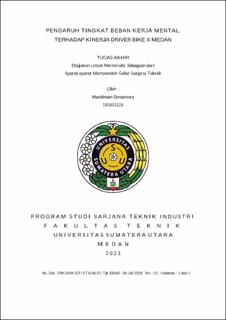Pengaruh Tingkat Beban Kerja Mental terhadap Kinerja Driver Bike X Medan

Date
2023Author
Simamora, Hardiman
Advisor(s)
Napitupulu, Humala Lodewijk
Metadata
Show full item recordAbstract
Drivers are the spearhead of ride hailing companies. However, many X Bike
Drivers complain because Drivers' income is considered to be increasingly
inadequate due to the high deductions that must be paid by X Bike Drivers to the
company. As a result, to fulfill income, X Bike Drivers have to work harder and of
course the perceived mental workload also increases, which is expected to affect
the performance of these Drivers. Using the NASA-TLX method, the mental
workload of 100 X Bike Drivers in Medan was measured. And the performance will
be measured so that a linear regression analysis can be carried out to determine
the effect of mental workload on the performance of X Bike Drivers. Measurement
of mental workload is carried out using 6 indicators, namely mental needs, physical
needs, time requirements, performance, effort, and frustration levels. Meanwhile,
performance is measured by indicators of the level of completion of orders and the
average Driver rating. The measurement results were obtained from 100 X Bike
Drivers, 92 people (92%) experienced moderate category mental workload, and 8
people (8%) experienced rather high category mental workload. As well as the
performance of Drivers classified as Very Good as many as 12 people (12 %),
Good as many as 34 people (34%), Somewhat Good as many as 28 people (28%),
Somewhat Bad as many as 19 people (19%), Bad as many as 7 people (7%). After
the linear regression test was carried out, the path coefficient (R) was 0,606 which
indicated the strength of the relationship between mental workload and
performance in this study was strong in a positive direction. And the R Square value
of 0,376 means that 36,7% mental workload affects the performance of X Bike
Drivers. Then the coefficients are calculated and the constant value (a) is 81,434
and the coefficient value (b) is 0,295, so the resulting regression equation is: Y =
81,434 + 0,295 X. Next, using RapidMiner, clustering the mental workload and
performance of X Bike Drivers is done to find out optimal mental workload value
for X Bike Drivers so that their performance is good.
Collections
- Undergraduate Theses [1597]
